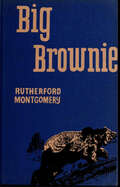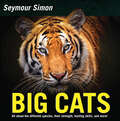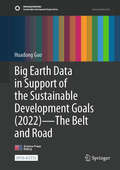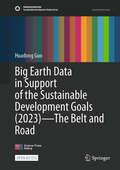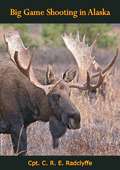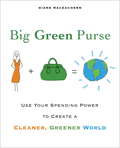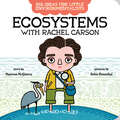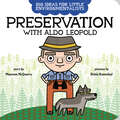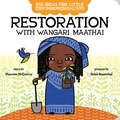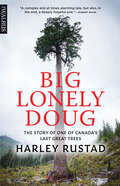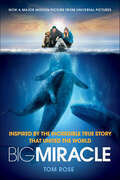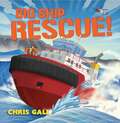- Table View
- List View
Big Brownie
by Rutherford MontgomeryIN the story of Big Brownie, one of the rare Kodiak bears, largest flesh-eating animal in the world, Rutherford Montgomery gives a wonderful portrait of a true king of beasts, in a swift tale of action and wild life. As Big Brownie and his sister, orphaned by bear hunters, grow up alone, learning their wilderness lessons and the danger of human foes, we see how these powerful, slow-to-anger animals' live, fish, and hunt on their island homes. Drama comes when the Miller Sheep Company sends bear hunters to Happy Valley, the Kodiak Island retreat of Ruth Keller and her father, to exterminate the bears. The Kellers love and understand these great fellows, particularly Big Brownie, and they have learned to live in peace with them. Ruth cleverly outwits the bear hunters, only to find that the sheep company can legally evict her father and herself. It is then that young Chuck Miller convinces Ruth he is on her side, despite his name, and solves their problem. BIG BROWNIE is based on the dramatic true story of the successful fight of nature lovers and conservationists to protect the Kodiak bear when it was faced with extinction. And today BIG BROWNIE has added interest, for Mr. Montgomery gives a vivid picture of Kodiak Island, so near our present Alaskan fighting front.
Big Bucks The Benoit Way
by Bryce M. TowsleyBy following the legendary Benoit family, hunters can learn to track and harvest the biggest whitetail bucks on consistent basis. The full-color photography and time-tested methods will gain anyone the advantage over whitetails and the bragging rights over camp.
Big Cats: Revised Edition
by Seymour SimonIn this completely updated edition of Big Cats, award-winning writer Seymour Simon celebrates the grace and power of lions, tigers, leopards, jaguars, cheetahs, pumas, and snow leopards. Readers will learn all about how they hunt, care for their young, and rest in their varied natural habitats. This nonfiction picture book is packed with information and beautiful color photographs. Cat fans and kids ages 6 to 10 looking for facts, whether for a report or just for fun, will find much to like in Big Cats.This updated edition includes:Author’s noteStunning full-color photographsGlossaryIndexAdditional reading sourcesSupports the Common Core Learning Standards, Next Generation Science Standards, and the Science, Technology, Engineering, and Math (STEM) standards.
Big City Bees
by Maggie De Vries Renne BenoitVivid writing and luminous art combine to tell a modern story that introduces young readers to the wonders of bees For city kids like Sophie and Matthew, growing pumpkins is a big thrill.But they're worried. They know they need bees to make their pumpkins grow. But will the bees find their garden? Are there even bees in the city?So one day, Grandpa and the children set out to look for bees. They arrive downtown just in time to see something amazing: a buzzing ball of bees hovers from the branch of a nearby tree. And high on the terrace of a towering hotel are four brightly coloured beehives!For Matthew and Sophie, this is the beginning of an exciting adventure. All summer they tend their plants, eagerly watching as their seeds sprout and turn into shoots, then vines and leaves. But they're still worried. Will the bees come when they're needed?Finally, the golden pumpkin flowers appear among the leaves. The female flowers will be open for just one day, and Matthew and Sophie arrive at the garden early in the morning to wait and watch. Will the bees arrive in time to pollinate the plants?
Big Coal: The Dirty Secret Behind America's Energy Future
by Jeff GoodellNew York Times–Bestselling Author:“Should be ready by anyone who owns a microwave, or an iPod, or a table lamp, which is to say everyone.” —Elizabeth Kolbert, Pulitzer Prize–winning author of The Sixth ExtinctionA Kirkus Reviews Best Book of the YearCoal is still a significant source of power in the United States—and coal mining is still a deadly and environmentally destructive industry. Much of the carbon dioxide released into the atmosphere each year comes from coal-fired power plants, and in recent decades air pollution from coal plants has killed more than half a million Americans. In this eye-opening call to action, Jeff Goodell explains the costs and consequences of America’s addiction to coal and discusses how we can kick the habit.“[A] compelling indictment . . . powerful.” —The New York Times Book Review“Goodell’s description of the mining-related deaths, the widespread health consequences of burning coal and the impact on our planet’s increasingly fragile ecosystem make for compelling reading, but . . . are not what lift this book out of the ordinary. That distinction belongs to Goodell’s fieldwork, which takes him to Atlanta, West Virginia, Wyoming, China and beyond.” —Publishers Weekly (starred review)“Goodell does a first-rate job of balancing environmental concerns with interviews from the human faces associated with ‘Big Coal’.” —Library Journal
Big Dog, Little Dog
by Seth CasteelFrom the bestselling photographer behind Underwater Dogs and Underwater Puppies, a new irresistibly cute concept featuring tiny dogs and giant dogs side by side.A collection of stunning photographs, each featuring two dogs: one big, one small. These unexpected pairs are utterly adorable, making this book the perfect gift for the biggest (or littlest) dog lover in your life, or the perfect coffee-table book for anyone who loves cute pups.
Big Earth Data in Support of the Sustainable Development Goals (Sustainable Development Goals Series)
by Huadong GuoThis open access book showcases the innovative practices of Big Earth Data methods through a collection of global comprehensive case studies to monitor and evaluate indicators for seven SDGs, i.e., zero hunger (SDG 2), clean water and sanitation (SDG 6), affordable and clean energy (SDG 7), sustainable cities and communities (SDG 11), climate action (SDG 13), life below water (SDG 14), life on land (SDG 15), and to analyzes the interactions among multiple SDGs indicators. The emphasis on Big Earth Data is highly relevant within the context of growing global challenges. Disaster risk mitigation, climate change, global food security, resource management, and environmental challenges all are interlinked through earth systems and processes that are independent of human constructs. Therefore these case studies highlight methods and practices of spatial information mining and integrated SDG evaluation, which include evaluating the synergy and trade-off relationships among the SDGs in the context of their correlations; simulating multiple indicators’ interactions in environmental, economic, and social scenarios in the context of their temporal variations; designing integrated evaluations of regional SDGs in the context of experience with the study of multiple indicators. Big Earth Data therefore has the potential to support informed policy and decision support at global, regional, and local scales.
Big Earth Data in Support of the Sustainable Development Goals (Sustainable Development Goals Series)
by Huadong GuoThis open access book showcases the innovative practices of Big Earth Data methods through a collection of comprehensive case studies from China to monitor and evaluate indicators for seven SDGs, i.e., zero hunger (SDG 2), clean water and sanitation (SDG 6), affordable and clean energy (SDG 7), sustainable cities and communities (SDG 11), climate action (SDG 13), life below water (SDG 14), life on land (SDG 15), and to analyze the interactions among multiple SDGs indicators. The emphasis on Big Earth Data is highly relevant within the context of growing global challenges. Disaster risk mitigation, climate change, global food security, resource management, and environmental challenges all are interlinked through earth systems and processes that are independent of human constructs. Therefore, these case studies highlight methods and practices of spatial information mining and integrated SDG evaluation, which include evaluating the synergy and trade-off relationships among the SDGs in the context of their correlations; simulating multiple indicators’ interactions in future environmental, economic and social scenarios in the context of their temporal variations; designing integrated evaluations of regional SDGs in the context of experience with the study of multiple indicators. Big Earth Data therefore has the potential to support informed policy and decision support at global, regional, and local scales.
Big Earth Data in Support of the Sustainable Development Goals (Sustainable Development Goals Series)
by Huadong GuoThis open-access book presents innovative applications of Big Earth Data through a set of comprehensive case studies conducted globally and in countries and regions along the Belt and Road. The studies demonstrate how advanced data methods can be employed to monitor and evaluate indicators for seven Sustainable Development Goals (SDGs): zero hunger (SDG 2), clean water and sanitation (SDG 6), affordable and clean energy (SDG 7), sustainable cities and communities (SDG 11), climate action (SDG 13), life below water (SDG 14), and life on land (SDG 15). In addition, the book explores the complex interactions among multiple SDG indicators. The emphasis on Big Earth Data is particularly timely in view of pressing global challenges. Issues such as disaster risk reduction, climate change, food security, resource management, and environmental protection are inherently interconnected through Earth systems and processes that transcend political and social boundaries. Within this context, the case studies highlight methodological advances in spatial information mining and integrated SDG evaluation, including analyzing synergies and trade-offs among SDGs through correlation studies, simulating interactions of multiple indicators under projected environmental, economic, and social scenarios, and developing integrated frameworks for regional SDG assessment. Taken together, these findings illustrate the potential of Big Earth Data to provide robust scientific evidence in support of policy formulation and decision-making at global, regional, and local levels.
Big Ecology
by David C. ColemanIn Big Ecology, David C. Coleman documents his historically fruitful ecological collaborations in the early years of studying large ecosystems in the United States. As Coleman explains, the concept of the ecosystem--a local biological community and its interactions with its environment--has given rise to many institutions and research programs, like the National Science Foundation's program for Long Term Ecological Research. Coleman's insider account of this important and fascinating trend toward big science takes us from the paradigm of collaborative interdisciplinary research, starting with the International Geophysical Year (IGY) of 1957, through the International Biological Program (IBP) of the late 1960s and early 1970s, to the Long-Term Ecological Research (LTER) programs of the 1980s.
Big Game Shooting in Alaska
by C. R. E. RadclyffeEmbark on a thrilling adventure through the rugged wilderness of Alaska with C. R. E. Radclyffe's Big Game Shooting in Alaska. This captivating account provides an exhilarating glimpse into the world of big game hunting at the turn of the 20th century, offering readers a front-row seat to the challenges and triumphs of tracking and hunting some of the most majestic creatures in the Alaskan frontier.C. R. E. Radclyffe, an experienced hunter and storyteller, shares his firsthand experiences of hunting in one of the world’s most remote and untamed landscapes. Through vivid and engaging narrative, Radclyffe brings to life the breathtaking beauty and harsh realities of the Alaskan wilderness, capturing the essence of the hunt and the spirit of adventure that drives it.Big Game Shooting in Alaska delves into the pursuit of various big game species, including moose, caribou, grizzly bear, and mountain goat. Radclyffe provides detailed descriptions of the hunting techniques, equipment, and strategies employed, as well as the physical and mental stamina required to navigate the challenging terrain and extreme weather conditions.The book also offers insights into the natural history and behavior of the animals, enriching the reader’s understanding of the intricate dynamics between hunter and prey. Radclyffe's respect for the wildlife and the environment shines through, emphasizing the importance of ethical hunting practices and conservation.Big Game Shooting in Alaska is an essential read for hunting enthusiasts, outdoor adventurers, and anyone fascinated by the untamed beauty of Alaska. C. R. E. Radclyffe’s masterful storytelling and keen observations make this book a timeless classic, celebrating the spirit of adventure and the enduring allure of the wild.
Big Game Shooting in Alaska
by Cpt. C. R. E. RadclyffeCaptain Radclyffe was an English gentleman-hunter who visited Alaska in 1903. He bagged Dall sheep on the Kenai Peninsula, back then a relatively new destination for sport hunting. He shot excellent brown bear and moose, one a 57-incher on Kussiloff Lake on the Alaska Peninsula. On his final bear hunt, a sow charged him and his native guide abandoned him. He was arrested for game law violations that prematurely ended his hunt for sheep, adding another interesting dimension to this well-written story. The charges against Radclyffe were later dismissed since he had an off-season permit to collect for the British Museum, but the author’s partner was not so lucky. Radclyffe writes of how the judge enjoyed rubbing the dismissal into the face of the arresting marshal, and he paints a vivid picture of the interactions of the hunters, guides, and authorities. After all his troubles, he lost most of his trophies because of shipping problems related to the Russo-Japanese War. Radclyffe had a way with words that makes the account of his trip to the Alaskan frontier come alive. This is an extremely interesting and well-written account of the game as well as the people that existed 100 years ago in the frozen North. Big Game Shooting in Alaska is dedicated to Theodore Roosevelt, a longtime friend of Radclyffe’s.Richly illustrated throughout.
Big Game of Botswana: The Tragic History of a Once Great Southern African Fauna
by Clive SpinageQuoting contemporary accounts from hunters, missionaries and traders from the early nineteenth century onwards, this book illustrates the ecology of the country as it was emphasizing its rich large mammal fauna, its decline from increasing aridity of the country, it destruction by hunters, by disease, and most importantly, destruction of its vast herds, notably of wildebeest, due to the developing beef export economy and the erection of veterinary cordon fences depriving the large game of migration routes in times of drought. Once possessing one of the greatest animal displacements in Africa, with huge migrations of antelope, this book underlines the reality that the fauna of Botswana today is but a tiny remnant of what was perhaps once one of the the greatest spectacles of big game on earth. It shows how the decline came about -- and the controls exercised by tribal chiefs illustrating the indigenous peoples’ attitudes, and eventual protective measures both tribal and statutory. Whereas the pessimistic predictions of extinction at the end of the nineteenth century have happily not come true, nonetheless, the continued existence of this once great fauna is increasingly threatened by climate change threatening an already fragile balance, and human population increase with its increasing economic demands and changes in land use. The study fills a gap in the literature of African wildlife conservation and is distinctive by drawing upon a rich historical background.
Big Green Purse: Use Your Spending Power to Create a Cleaner, Greener World
by Diane MaceachernProtecting our environment is one of the biggest issues facing our planet today. But how do we solve a problem that can seem overwhelming-even hopeless? As Diane MacEachern argues in Big Green Purse, the best way to fight the industries that pollute the planet, thereby changing the marketplace forever, is to mobilize the most powerful consumer force in the world-women. MacEachern's message is simple but revolutionary. If women harness the "power of their purse" and intentionally shift their spending money to commodities that have the greatest environmental benefit, they can create a cleaner, greener world. Spirited and informative, this book: - targets twenty commodities-cars, cosmetics, coffee, food, paper products, appliances, cleansers, and more-where women's dollars can make a dramatic difference; - provides easy-to-follow guidelines and lists so women can choose the greenest option regardless of what they're buying, along with recommended companies they should support; - encourages women to spend wisely by explaining what's worth the premium price some green products cost, what's not, and when they shouldn't spend money at all; and - differentiates between products that are actually "green" and those that are simply marketed as "ecofriendly." Whether readers want to start with small changes or are ready to devote the majority of their budget to green products, MacEachern offers concrete and immediate ways that women can take action and make a difference. Empowering and enlightening, Big Green Purse will become the "green shopping bible" for women everywhere who are asking, "What can I do? "
Big Ideas For Little Environmentalists: Ecosystems with Rachel Carson (Big Ideas for Little Environmentalists)
by Maureen McQuerryDiscover Rachel Carson's big ideas about protecting ecosystems and ways even the youngest kids can help, too! Even little children can make a positive impact on the environment. Rachel Carson was an environmentalist who studied the way the land, plants, and animals interact with each other, beginning when she was a child. She noticed that everything is connected, and all of nature must stay healthy for living things to thrive. When she realized that the chemicals people used outdoors were making plants, animals, and even other people sick, she began teaching others about the ecosystems, and how we must take care of them to keep the Earth balanced. Kids will see, through Rachel&’s curiosity and passion for all creatures, that even seemingly small choices can have big consequences on the world around them. Look for all of the books in the Big Ideas for Little Environmentalists series: Conservation with Jane Goodall, Restoration with Wangari Maathai, and Preservation with Aldo Leopold.
Big Ideas for Little Environmentalists: Conservation with Jane Goodall (Big Ideas for Little Environmentalists)
by Maureen McQuerryDiscover Jane Goodall's big ideas about conserving habitats and ways even the youngest kids can help, too! Even little children can make a positive impact on the environment. Jane Goodall has dedicated her life to studying chimpanzees, and realized that sometimes people hurt the places where animals have always lived. She began to teach others how we can enjoy nature while also making sure that the homes of animals aren&’t suffering. Kids will come away from this book with questions about what animal habitats they can care for in their own community, and how conservation work makes sure all people and animals have a healthy home. Look for the other books in the Big Ideas for Little Environmentalists series: Restoration with Wangari Maathai, Preservation with Aldo Leopold, and Ecosystems with Rachel Carson.
Big Ideas for Little Environmentalists: Preservation with Aldo Leopold (Big Ideas for Little Environmentalists)
by Maureen McQuerryDiscover Aldo Leopold's big ideas about preserving nature and ways even the youngest kids can help, too!Little children can make a big impact on the environment. Aldo Leopold transformed his childhood love for nature into a life dedicated to protecting and preserving the environment. He encouraged the idea of keeping wilderness areas untouched, so that all people could visit areas free of human interference. Kids will come away from this book excited about the nature they have access to and how to help preserve other wilderness areas. Look for all of the books in the Big Ideas for Little Environmentalists series: Conservation with Jane Goodall, Restoration with Wangari Maathai, and Ecosystems with Rachel Carson.
Big Ideas for Little Environmentalists: Restoration with Wangari Maathai (Big Ideas for Little Environmentalists)
by Maureen McQuerryDiscover Wangari Maathai's big ideas about restoring nature and ways even the youngest kids can help, too! Even little children can make a positive impact on the environment. Wangari Maathai grew up in Kenya, and her childhood was spent playing beneath mugumo fig trees. Over time, most of the trees in her area were cleared and she noticed how that made many people and animals suffer. Wangaari realized that trees are important for the health of the land and all who live on it, so she worked to plant millions of trees to make the land healthy again. Kids will begin to see through Wangaari that it is never too late to help restore damaged land back to what it once was, and they can help their community take care of struggling environments. Look for all of the books in the Big Ideas for Little Environmentalists series: Conservation with Jane Goodall, Preservation with Aldo Leopold, and Ecosystems with Rachel Carson.
Big Lonely Doug: The Story of One of Canada’s Last Great Trees
by Harley RustadIn the tradition of John Vaillant’s modern classic The Golden Spruce comes a story of the unlikely survival of one of the largest and oldest trees in Canada.On a cool morning in the winter of 2011, a logger named Dennis Cronin was walking through a stand of old-growth forest near Port Renfrew on Vancouver Island. He came across a massive Douglas fir the height of a twenty-storey building. Instead of allowing the tree to be felled, he tied a ribbon around the trunk, bearing the words “Leave Tree.” The forest was cut but the tree was saved. The solitary Douglas fir, soon known as Big Lonely Doug, controversially became the symbol of environmental activists and their fight to protect the region’s dwindling old-growth forests.Originally featured as a long-form article in The Walrus that garnered a National Magazine Award (Silver), Big Lonely Doug weaves the ecology of old-growth forests, the legend of the West Coast’s big trees, the turbulence of the logging industry, the fight for preservation, the contention surrounding ecotourism, First Nations land and resource rights, and the fraught future of these ancient forests around the story of a logger who saved one of Canada's last great trees.
Big Miracle: Inspired by the Incredible True Story that United the World
by Tom RoseNow a major motion picture starring Drew Barrymore, Ted Danson, Kristen Bell, Tim Blake Nelson, John Krasinski, and Vinessa Shaw—an account of the dramatic rescue of three gray whales trapped under the ice in Alaska in 1988.Set in Cold War–era 1988, Big Miracle tells the real story behind the remarkable, bizarre, and oftentimes uproarious event that mesmerized the world for weeks. On October 7, an Inuit hunter near Barrow, Alaska, found three California Gray whales imprisoned in the Arctic ice. In the past, as was nature's way, trapped whales always died. Not this time. Tom Rose, who was covering the event for a Japanese TV station, compellingly describes how oil company executives, environmental activists, Inupiat people, small business people, and the U.S. military boldly worked together to rescue the whales. He also tells the stories of some of the more than 150 international journalists who brought the story to the world's attention. The rescue was followed by millions of people around the world as Ronald Reagan and Mikhail Gorbachev joined the forces of their two nations to help free the whales.
Big Muddy Blues: True Tales and Twisted Politics Along Lewis and Clark's Missouri River
by Bill LambrechtAmerica's Missouri River may be the nation's longest and most historically significant river, encompassing many of America's natural wonders between Missouri and Montana, draining almost 600,000 square miles in ten states and part of Canada, and, after Lewis and Clark's expedition 200 years ago, opening the West to a frenzied rush of expansion.But the Missouri is also the site of a vast, politically driven drama. It tops a list of emerging big-stakes river wars around the country that pit conservation, development, farm, barge, American Indian, and government interests against one another in clashes made even more complicated by the scarcity of water in many river basin states.In Big Muddy Blues, veteran journalist Bill Lambrecht uses the bicentennial of Lewis and Clark's epic adventure west as a lens to show the other side of the story: what's been lost over 200 years. And the losses, on top of the 120 miles cut off the river by Army Corps stabilization efforts, aren't slight. Dependent on every word uttered in courtrooms and legislatures for their futures are more than 80 rare and endangered species, the family farms that require a stabilized river, the barges of shippers that require a heavier flow, and dozens if not hundreds of sacred Native American burial grounds.Running through it all is the water--more than 2,300 miles of it--that slakes the thirst of people in one-sixth of the nation and has, in the last few hundred years, been home to Native Americans, explorers, and settlers; river pirates, shipwrecks, and steamboats; and farmers, conservationists, and the Army. This is the story of "Big Muddy," of its influence on the formation and stability of our nation and of its place in the center of an escalating river war that will set the stage for water wars in the decades to come.
Big Pig, Little Pig: A Year on a Smallholding in South-West France
by Jacqueline YallopAs heard on BBC Radio 4's Book of the Week'A delightful and entertaining memoir' Woman and HomeWhen Jacqueline moves to south-west France with her husband, she embraces rural village life and buys two pigs to rear for slaughter. But as she gets to know the animals better, her English sentimentality threatens to get in the way and she begins to wonder if she can actually bring herself to kill them. This is a memoir about that fateful decision, but it's also about the ethics of meat eating in the modern age, and whether we should know, respect and even love the animals we eat. At its heart, this book is a love story, exploring the increasing attachment of the author for her particular pigs, and celebrating the enduring closeness of humans and pigs over the centuries.
Big Red (Famous Dog Stories)
by Jim KjelgaardThis is the famous wilderness adventure of a boy and a dog who formed an unbreakable friendship. It is the moving, exciting story of Big Red’s heart and courage, and Danny’s discovery of what it takes to make a good dog and a good man. Their feud with Old Majesty, legendary bear of the Wintapi, and their fierce battle with a wolverine are peaks in an action-packed tale of true loyalty and courage.
Big Red and the Terrible Tomato Hornworm: Bloomers Island (Bloomers Island #3)
by Cynthia WylieIn Big Red and the Terrible Tomato Hornworms, Professor Sage holds a contest between the young Bloomers where each must choose their favorite vegetable to grow and care for. Here, young readers are introduced to the character of Big Red, who knows exactly what he wants to grow: tomatoes! After all, they are the main ingredient in some of his favorite foods: spaghetti, ketchup, and pizza. But as he starts planting, he discovers that he’ll have to battle hornworms to keep his tomatoes healthy and safe. In the end, he has to use his newfound gardening knowledge and peacemaking skills to work with the hornworms and save his tomatoes.Bloomers Island Garden of Stories picture books take young readers and listeners to Bloomers Island to experience the world of plants, flowers, and gardens through lively stories and lush illustrations.
Big Ship Rescue! (Big Rescue #0)
by Chris GallChris Gall gives boat books a fresh coat of paint in a bright story of tugboats, tools, and teamwork. Oh no! The Goliath has wrecked in a storm. First the crew has to be rescued, then the ship has to be made safe, refloated, and winched off the rocks. It’s a good thing Salvage Master Miley is on the scene with her tugboat, the Mighty Mackerel. It’s a tough job, but with the tug’s powerful engines, propellers, towlines, and winches, Miley and her salvage team have what it takes to bring Goliath back to port. With lively storytelling, engaging artwork, and plenty of mechanical detail, acclaimed author/illustrator Chris Gall sails through a brave and stormy tale of nautical machinery and collaboration that’s just right for little engineers.
